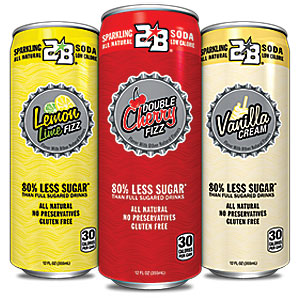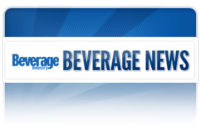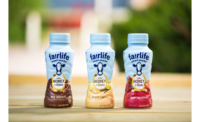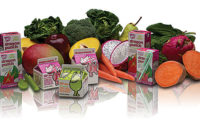Last month, the U.S. Department of Agriculture (USDA) initiated its new Smart Snacks in School nutrition standards, which affect the sale of foods and beverages that are not part of federally supported meals programs. This includes beverages sold in vending machines, a la carte lines and school stores during the school
|
day. Designed to help make the healthy choice an easy choice for students, the new rules primarily impact beverages in terms of portion size and calorie count and are set up according to age group.
For instance, milks and juices are limited to 8-ounce portion sizes in elementary schools and 12-ounce sizes in middle and high schools. However, the standards are a little more lenient for high schoolers. Participating high schools are permitted to sell zero-calorie beverages in portions as large as 20 ounces, and low-calorie beverages with up to 40 calories per 8 ounces or 60 calories per 12 ounces in portions as large as 12 ounces. Plus, these schools are able to sell caffeinated beverages, including coffee and energy drinks, that meet the calorie and portion size requirements. However, the USDA states that it encourages school districts to exercise caution when selecting items for sale to their students. The USDA adds that it will continue to monitor the Food and Drug Administration’s (FDA) work on caffeine and will consider revising the nutrition standards in the future as appropriate.
All schools are permitted to sell still or sparkling water, unflavored low-fat milk, unflavored or flavored fat-free milk and dairy alternatives, 100 percent fruit and vegetable juice, and still or sparkling 100 percent fruit and vegetable juice diluted with water without any added sweeteners under the new regulations.
The Smart Snacks in School standards are an important component of First Lady Michelle Obama’s Let’s Move initiative to help fight childhood obesity, as well as the Healthy, Hunger-Free Kids Act of 2010, which authorizes funding and sets policy for the USDA’s core child nutrition programs: the National School Lunch Program; the School Breakfast Program; the Special Supplemental Nutrition Program for Women, Infants and Children; the Summer Food Service Program; and the Child and Adult Care Food Program. According to the School Nutrition Association, National Harbor, Md., nearly 100,000 kindergarten through grade 12 public and private schools nationwide participate in the National School Lunch Program and the School Breakfast Program.
Industry initiatives
Although schools now are preparing to meet the new Smart Snacks in School standards for the next school year, member companies of the American Beverage Association (ABA), Washington, D.C., have been meeting these standards for eight years through the ABA’s School Beverage Guidelines. This includes more than 170 active members, according to the ABA’s website.
The School Beverage Guidelines, which were developed by the ABA in partnership with the Alliance for a Healthier Generation, a joint venture between the American Heart Association and the William J. Clinton Foundation, removed full-calorie soft drinks and replaced them with water, milk and
100 percent juice in schools nationwide, says Chris Gindlesperger, senior director of public affairs for the ABA. Additionally, the guidelines have impacted beverage sales during high school extracurricular and after-school activities by adding diet and low-calorie beverage options, such as sports drinks and teas, he says. As a result of these initiatives, in 2012, the association reported a 90 percent reduction of calories from beverages in schools, he notes.
“Since then, there’s been some discussion that the USDA put into effect, [namely the Smart Snacks in School regulations], which, as they pertain to us, largely reflect what we did voluntarily years before, so we’re very proud of that,” Gindlesperger says.
He also calls out how the ABA’s Clear on Calories program supplements this effort.
“It goes across all of our packaging industry-wide, and it gives consumers the information that they need to make the choices that are right for them right at their fingertips,” Gindlesperger explains.
More recently, the ABA has expanded its Clear on Calories program to vending machines. The vending initiative places the caloric information from the products on selection buttons on vending machines, changes the product mix in the machines to include more low-calorie options, and places a sticker on the front of the vending machine that says, “Calories Count. Check Then Choose.” to remind consumers to make healthy choices. Currently, the Calories Count Beverage Vending Program has been rolled out in municipal buildings in Chicago, San Antonio and Washington, D.C.
Although the new Smart Snacks in School standards shouldn’t greatly impact companies that already follow the ABA’s School Beverage Guidelines, beverage companies looking to make their debut in the channel should familiarize themselves with the new requirements, says Diane Pratt-Heavner, director of media relations for the School Nutrition Association. They also should get feedback from the people making the purchasing decisions for school cafeterias to determine what their students are looking for as well as what the operators are looking for in terms of what they think will bring revenue to their programs, she adds.
“I would encourage them to really communicate as much as possible with the school nutrition directors to find out what their challenges are in terms of beverages and what products they’re specifically looking for, and then be very familiar with these new regulations,” Heavner says.
Operator pushback
Despite the good will of providing students with nutritional foods and beverages, not all schools are on board with the new Smart Snacks in School standards.
“We have seen some schools drop out of the program as a result of these standards or in anticipation of the standards,” Heavner says.
For instance, the Unionville-Chadds Ford School District in Pennsylvania recently opted to remove its 1,300 high school students from the program, according to a philly.com article. Its middle school and four elementary schools, however, will participate in the program. The district made this decision regarding its high school for financial reasons, saying that its revenue expectedly would decrease as a result of the program, according to the article. By opting out of the program, the school will lose approximately $38,000 in federal money but will make up for it in lunchtime revenue, the district’s supervisor of food services said in the article.
The School Nutrition Association’s Heavner explains that schools with a very low percentage of students who are eligible for free or reduced-price meals generally are the most likely to opt out of the program.
“Schools that participate in the National School Lunch and School Breakfast Programs get reimbursed for every meal that they serve,” she says. “Particularly for those schools that have a large number of children eligible for free and reduced-price meals, that can amount to a lot of funding.
“School districts want to make sure that particularly at-risk kids are getting meals at school and getting the nutrition that they need to be able to focus on their studies, so the only schools that would really be thinking about dropping out of the program are those that can afford to cover the price of that meal for their low-income students on their own without federal assistance,” she concludes.





